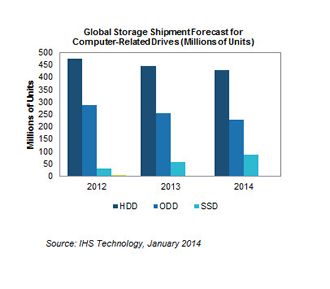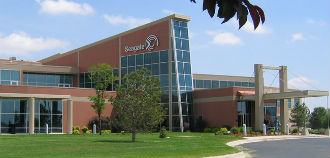Tag: hard drives
SSDs make the notebook grade
 Business users of notebooks can expect a plethora of notebooks in 2015 that use solid state drives (SSDs) rather than the traditional electromechanical storage.
Business users of notebooks can expect a plethora of notebooks in 2015 that use solid state drives (SSDs) rather than the traditional electromechanical storage.
SSDs are far faster at accessing operating systems and data than HDDs and Digitimes has talked to a number of suppliers that think their use will increase next year.
The main reason is that as SSDs proliferate, their prices will continue to drop and the report suggests that as many as a fifth of business notebooks will use them next year
SSDs are still expensive compared to HDDs however. Digitimes said that a 128GB flash drive will cost $60 in the next few months, but you can buy a one terabyte drive for that amount.
So the notebook vendors will probably use a combination of SSDs and HDDs in hybrid devices.
But it will be a while before notebooks intended for home use and using SSDs will be cheap enough for home use, although most analysts believe that time is not far away.
Entry level storage systems up
 The third quarter of 2014 saw personal and entry level storage shipments up by 4.8 percent compared to 2013, with 19 million units shipping.
The third quarter of 2014 saw personal and entry level storage shipments up by 4.8 percent compared to 2013, with 19 million units shipping.
That’s according to IDC analyst Jingwen Li. “The personal and entry level portion of the market saw good growth in higher capacity portable devices as well as personal cloud devices.”
Cloud storage is typically used for an entire household with entry level systems have higher capacity and at a price which people can afford.
While the market continues to be dominated by mainstream non hard drive vendors, with 50.5 percent market share, dedicated HDD vendors like Western Digital are nibbling at this dominance.
IDC predicts further growth in unit shipments in this, the fourth quarter, up by 15.1 percent year on year.
Single bay storage continues to be the most popular choice with 97.5 percent of the market, but dual bay and multiple bay systems are becoming more popular.
USB is still the most popular interface with Ethernet and Thunderbolt taking minor shares in the market.
Hard drives may become CPUs
 University of Sheffield scientists believe that hard drives used for storage on computers could act as CPUs as well.
University of Sheffield scientists believe that hard drives used for storage on computers could act as CPUs as well.
Dr Tom Hayward, from the university’s Faculty of Engineering, said: “Magnetic materials are useful for data storage because they can retain information without consuming energy. A computer built around a CPU made of magnetic materials should be much more power efficient than existing technologies, as it should be able to function with minimal energy consumption.”
How can it be done?
The team said it is possible to create logic gates from magnetic materials. “In wires of magnetic material, magnetism can form into swirling ‘tornadoes’, known as magnetic vortex domain walls,” said Dr Hayward.
The team used vortices where the magnetism turns clockwise to represent 0 and anticlockwise vortices to represent 1.
While the work so far has focused on simulations, the team is now ready to build experimental prototypes of logic gates and see whether they can be made smaller and run faster.
Storage sales down in 2013
 Shipments of storage products fell by five percent last year, said market research company IHS.
Shipments of storage products fell by five percent last year, said market research company IHS.
However, solid state drive shipments in 2013 doubled and the reason for the decline in the whole sector is because of contractions in the hard drive and optical disk drive sectors.
Shipments of storage including SSDs, conventional hard drives and optical drives totalled 755 million units. HDDs fell by seven percent to 444.4 million units, optical drives fell by 12 percent to 253 million units while SSDs rose by 82 percent to 57 million units, said IHS. The figures do not include non PC related drives.
The convential HDD sector suffered from the increase in the popularity of smartphones and tablets. However, the enterprise PC sector is more promising than the consumer end of the show.
SSDs are likely to rise by 50 percent during 2014, reaching 189 million units in 2017, which will be half the size of the HDD market which is expected to total 397 million in that year.
Huawei, HGST intro 6TB systems
 Hitachi Global Storage Technologies (HGST) and Chinese comms company Huawei said that they will deploy the Ultrastar He6 terabyte helium filled hard drives.
Hitachi Global Storage Technologies (HGST) and Chinese comms company Huawei said that they will deploy the Ultrastar He6 terabyte helium filled hard drives.
Huawei said that it is one of the first vendors to use the helium filled hard drives.
The use of helium instead of air lets the hard drives reduce shea resistance caused by the platter movement as well as letting standard 3.5-inch drives to include more platters.
Huawei claims that the drives improve capacity density by 87/5 percent, cuts power consumption by 23 percent and reduces temperature by four degrees Celsius.
The advantage of the drives also allows new designs for storage systems and datacentres, Huawei claimed.
Seagate hatches insurance scheme
 Storage company Seagate is introducing insurance plans to give customers some peace of mind.
Storage company Seagate is introducing insurance plans to give customers some peace of mind.
For $30, customers can sign up for two years of Seagate Rescue, where the company will save your lost data from a dodgy hard drive. Rescue and Replace, meanwhile, will not only recover your data but also send you a replacement hard drive.
Veep of marketing at Seagate, Scott Horn, suggested the company is actively trying to maintain its reputation of trust, as well as having it “provide peace of mind for those unforeseen events that might damage a drive or its contents”.
At the moment the service is only available at Seagate.com. In addition to the starting price of $30 for two years of Seagate Rescue, Rescue and Replace begins at $40 for two years, $50 or $60 for three and four respectively.
Rescuing data can prove expensive, but it will be up to the customer if they want to spend cash on a failure that may or may not happen.
For those even more paranoid about their data, it might be worth investing in an ioSafe hard drive, which can be submerged in water, run over with bulldozers, or blasted with a shotgun.
IDC notes strong storage growth
 IDC’s worldwide storage tracker has noted that the personal and entry level storage market has shot up 73.4 percent year on year – reaching 20.2 million units shipped in Q1 2013, with shipment value growing 54.1 percent at $1.8 billion.
IDC’s worldwide storage tracker has noted that the personal and entry level storage market has shot up 73.4 percent year on year – reaching 20.2 million units shipped in Q1 2013, with shipment value growing 54.1 percent at $1.8 billion.
In the first quarter, there was both strong shipment and revenue growth. The market has finally recovered from the floods in Thailand several years ago which led to a worldwide shortage in hard disks. Thanks to cheaper average selling prices, better products and more user awareness about the need for storage and back up, the market is picking up nicely.
Personal storage makes up 99.1 percent of shipped PELS units and 89.8 percent of values for the quarter. Dual bay product shipments were up 43.6 percent year on year, but single bay devices are overwhelmingly still the most popular choice at 96.8 percent of all units shipped. Higher bay devices saw growth at 38.2 percent year on year.
3.5″ devices lost some market share to the 2.5″ form factor, declining 2.6 percentage points for the year. 3.5″ and 2.5″ devices did both see shipments increase, at 56 and 79.7 percent respectively.
Consumers are flocking to higher capacity storage, generally. 2TB devices made up 49.9 percent of the 3.5″ personal storage market, while 1TB devices held 50.6 percent market share for 2.5″ devices. 4TB devices had the most market share in the entry level segment at 28.3 percent of units shipped.
USB is still the dominant interface, with an increase of 76.4 percent units shipped. Ethernet grew 68.8 percent. Thunderbolt grew plenty at 5102.7 percent – but with a tiny base.






